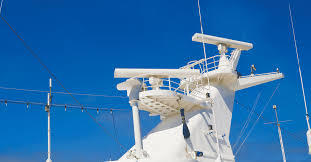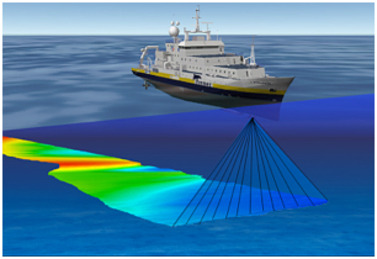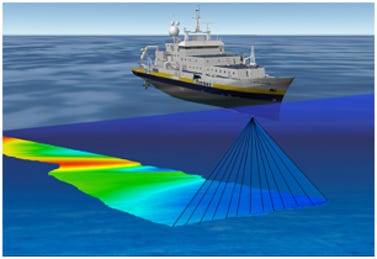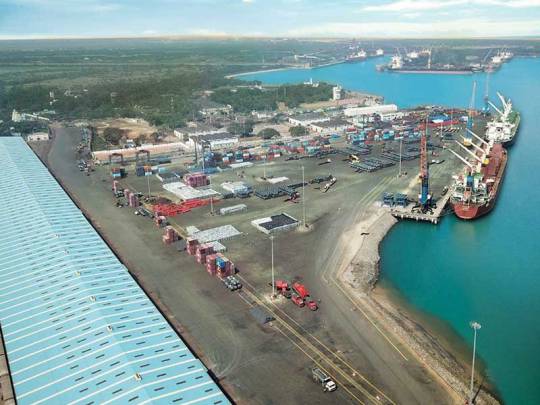Don't wanna be here? Send us removal request.
Text
VSAT Antennas: Enhancing Communication in a Digital World
In the age of digital connectivity, high-speed internet access is no longer a luxury but a necessity. Whether it's for business, education, or simply staying in touch with loved ones, reliable internet connectivity is crucial. However, in remote or challenging environments such as aboard Maule aircraft, marine vessels, or during offshore activities, traditional internet options often fall short. This is where VSAT antennas come into play, offering a beacon of hope for seamless connectivity even in the most remote locations.

VSAT Antennas: Revolutionizing Connectivity VSAT antennas are compact, yet powerful devices that enable high-speed internet access via satellite communication. Unlike traditional internet infrastructure that relies on terrestrial cables, VSAT antennas communicate directly with satellites orbiting the Earth, bypassing the limitations of geographical barriers. This makes them ideal for applications such as maritime communication, aviation, and remote industrial operations.
The Role of VSAT Antennas in Remote Environments In environments like Maule aircraft, where traditional internet access is impractical, VSAT antennas offer a lifeline. These antennas can be mounted on aircraft, providing pilots and passengers with uninterrupted internet access even at high altitudes and over vast expanses of uninhabited terrain. Similarly, in the maritime industry, VSAT antennas enable constant communication between vessels and onshore operations centers, facilitating safer navigation and efficient logistics management. Furthermore, in offshore industries such as oil and gas exploration, VSAT antennas support critical operations by ensuring real-time data transmission for tasks like marine radars and echosounder systems.
Advantages of VSAT Antennas One of the primary advantages of VSAT antennas is their ability to deliver high-speed internet access irrespective of location. Whether you're flying over the Arctic Circle or sailing across the Pacific Ocean, VSAT antennas keep you connected. Moreover, these antennas offer low latency, ensuring smooth video conferencing, real-time data transmission, and seamless web browsing. Additionally, VSAT networks are highly scalable, allowing businesses to expand their connectivity infrastructure as needed without significant investments in physical infrastructure.
Challenges and Considerations While VSAT antennas offer numerous benefits, they also present some challenges. One of the main concerns is cost, as both the equipment and satellite bandwidth can be expensive. However, advancements in technology are gradually driving down costs, making VSAT solutions more accessible to a broader range of users. Another consideration is signal interference, which can occur due to weather conditions or physical obstacles. Proper antenna placement and signal management strategies can mitigate these issues to ensure reliable connectivity.

Conclusion In a world where connectivity is paramount, VSAT antennas emerge as a beacon of hope for those operating in remote or challenging environments. From Maule aircraft soaring through the skies to maritime vessels navigating treacherous waters, VSAT antennas provide the lifeline needed to stay connected. With their ability to deliver high-speed internet access regardless of location, low latency, and scalability, VSAT antennas are indeed the future of connectivity in remote environments. As technology continues to evolve and costs decrease, we can expect VSAT antennas to play an even more significant role in shaping the way we communicate and conduct business in the years to come.
0 notes
Text
The Ultimate Showdown: VSAT Antennas vs. Traditional Satellite Dishes
In today's fast-paced digital era, access to high-speed internet is no longer a luxury but a necessity. Whether it's for business operations, educational purposes, or simply staying connected with loved ones, reliable internet connectivity is crucial. However, in remote areas or places with limited infrastructure, obtaining such connectivity can be a challenge. This is where VSAT antennas come into play, offering a promising solution for high-speed internet access, even in the most remote locations.

The Role of VSAT Antennas:
VSAT, which stands for Very Small Aperture Terminal, is a technology that enables satellite communication. These antennas are compact in size but mighty in their capabilities, making them ideal for various applications, including internet access, voice communication, and data transmission. Unlike traditional satellite dishes, VSAT antennas require minimal space and can be easily installed on different platforms, ranging from Maule aircraft to maritime vessels.
VSAT Antennas in Aviation (Maule Aircraft):
For aircraft like the Maule, which often operate in remote or rugged terrains, maintaining constant communication is essential for safety and operational efficiency. VSAT antennas provide a reliable means of internet connectivity, allowing pilots to access real-time weather updates, navigation charts, and communication with ground control. This ensures smoother flights and enhances overall safety for both passengers and crew.
VSAT Antennas in Maritime Applications (Marine Radars and Echosounder):
Maritime vessels rely heavily on communication and navigation systems to navigate safely through waters and stay connected with onshore operations. VSAT antennas play a vital role in enabling high-speed internet access on board, facilitating tasks such as email communication, video conferencing, and access to weather forecasts. Additionally, these antennas integrate seamlessly with marine radars and echosounders, enhancing their functionality and providing captains with valuable data for navigation and situational awareness.

Conclusion:
In conclusion, VSAT antennas represent the future of high-speed internet access, offering a reliable solution for connectivity in even the most remote and challenging environments. From Maule aircraft to maritime vessels, these antennas provide a seamless means of communication and data transmission, enhancing safety, efficiency, and productivity across various industries. As technology continues to advance, the role of VSAT antennas will only grow, further bridging the digital divide and connecting the world like never before.
0 notes
Text
VSAT Antennas: The Future of High-Speed Internet Access
In today’s fast-paced world, access to high-speed internet is no longer a luxury but a necessity. Whether for business, education, or entertainment, reliable internet connectivity is crucial. However, in remote areas or on-the-move scenarios such as marine vessels and aircraft, traditional internet infrastructure often falls short. This is where VSAT antennas come into play, revolutionizing high-speed internet access.

The Role of VSAT Antennas:
VSAT antennas serve as a gateway to the digital world, providing high-speed internet access in areas where terrestrial connections are limited or non-existent. These compact terminals utilize satellite communication technology to establish a link with geostationary satellites orbiting the Earth, enabling data transmission and reception with remarkable efficiency.
Benefits of VSAT Antennas:
1.Global Connectivity: VSAT antennas offer global coverage, bridging the gap between remote locations and the digital realm. Whether on a remote island, a Maule aircraft soaring above the clouds, or a vessel navigating the vast ocean, VSAT antennas ensure uninterrupted connectivity.
2.High-Speed Data Transfer: With VSAT antennas, users can enjoy high-speed internet comparable to terrestrial broadband connections. This enables seamless streaming, rapid file downloads, and smooth video conferencing even in the most remote environments.
3.Reliability: VSAT technology boasts high reliability, unaffected by terrestrial infrastructure vulnerabilities such as cable cuts or network congestion. This ensures consistent connectivity, vital for critical operations in sectors like maritime, aviation, and emergency response.
Applications Across Industries:
1.Maritime Sector: VSAT antennas have revolutionized communication onboard vessels, facilitating efficient crew management, remote monitoring of vessel systems, and seamless data exchange between ships and shore. Marine radars and echosounders integrated with VSAT systems enhance navigational safety and situational awareness at sea.
2.Aviation Industry: In aviation, VSAT antennas installed on aircraft such as Maule aircraft ensure reliable internet access during flight, enhancing passenger experience and enabling real-time cockpit communication. Pilots can access weather updates, flight plans, and navigational charts, improving flight efficiency and safety.
Challenges and Solutions:
While VSAT antennas offer unparalleled connectivity, certain challenges exist, including initial setup costs, signal latency, and susceptibility to adverse weather conditions such as heavy rainfall or extreme winds. However, ongoing advancements in technology are addressing these challenges. Innovations in antenna design, satellite constellation optimization, and signal processing algorithms are enhancing performance and reliability, making VSAT antennas increasingly robust and cost-effective.

Conclusion:
In a digitally interconnected world, access to high-speed internet is indispensable, regardless of geographical location or mobility. VSAT antennas emerge as the cornerstone of global connectivity, empowering industries such as maritime, aviation, and remote communities with seamless access to the digital realm. With their ability to transcend geographical barriers and deliver reliable, high-speed internet access, VSAT antennas truly represent the future of connectivity, ensuring that no corner of the globe remains offline.
0 notes
Text
Sailing Through Paradip Port: A Journey into India's Maritime Heritage
India, with its rich maritime history dating back millennia, boasts of numerous ports that have played crucial roles in its economic and cultural development. Among these ports, Paradip Port stands as a testament to India's maritime prowess and its journey through the tides of time. Situated on the eastern coast of India, in the state of Odisha, Paradip Port holds a special place in the country's maritime heritage. In this article, we embark on a journey to explore the significance, history, and contemporary relevance of Paradip Port, delving into its evolution and contributions to India's maritime trade.

0 notes
Text
From Port to Port: The Fascinating Journey of Maritime Transport
Maritime transport, often referred to as shipping, is the backbone of global trade, facilitating the movement of goods and commodities across oceans and seas. It's a fascinating industry with a rich history and a crucial role in shaping the world economy. From the early days of sailboats to today's massive container ships, the journey of maritime transport has been marked by innovation, challenges, and significant impacts on societies worldwide.

0 notes
Text
P3 Aircraft: The Backbone of Maritime Patrol and Surveillance
Maritime patrol and surveillance play a pivotal role in safeguarding coastal borders and ensuring maritime security. At the heart of these operations lies the formidable P3 Aircraft, serving as the backbone of such endeavors. With its robust capabilities and versatile functionalities, the P3 Aircraft stands as a symbol of reliability and efficiency in maritime missions worldwide.

0 notes
Text
Flying High with Maule Aircraft: Discovering the Beauty of Aviation EngineeringPrimary
Welcome aboard as we embark on an exhilarating journey into the world of aviation engineering, with a focus on the remarkable Maule Aircraft. From its humble beginnings to its current status as a symbol of innovation and reliability in the skies, Maule Aircraft has captured the hearts of aviation enthusiasts worldwide. In this article, we'll delve into the history, design, and enduring appeal of Maule Aircraft, exploring what makes them soar above the rest.

0 notes
Text
Dive Deeper: How Echosounders Revolutionize Underwater Mapping
Underwater exploration has always captivated humanity's imagination. From hidden treasures to uncovering the mysteries of the deep, understanding the underwater world remains a fascinating endeavor. However, exploring the depths of oceans, lakes, and rivers presents unique challenges. One of the critical tools aiding this exploration is echosounders. In this article, we will delve into the revolutionary role echosounders play in underwater mapping, unlocking secrets hidden beneath the waves.

0 notes
Text
Stay Connected Anywhere with FleetBroadband: The Ultimate Solution for Seamless Communication
In today's interconnected world, staying connected is not just a convenience; it's a necessity, especially for those operating in remote areas or at sea. Whether it's for business, emergency response, or simply keeping in touch with loved ones, reliable communication is paramount. Enter FleetBroadband, the ultimate solution for seamless communication, offering connectivity wherever you are, whenever you need it.

0 notes
Text
The Rise of Paradip Port: A Game-Changer in India's Maritime Industry

0 notes
Text
Navigate with Confidence: The Top Marine Radars on the Market

0 notes
Text
Akash Missile: Revolutionizing Air Defense Systems Worldwide

Akash Missile: A Brief Overview
The Akash Missile, developed by the Defence Research and Development Organisation (DRDO) of India, represents a paradigm shift in air defense capabilities. Designed to intercept and destroy aerial threats with precision, the Akash Missile system boasts versatility and effectiveness in various operational scenarios.
Key Features of the Akash Missile
The Akash Missile system is characterized by several key features that distinguish it from conventional air defense systems:
Multi-Target Capability: One of the most remarkable aspects of the Akash Missile system is its ability to engage multiple targets simultaneously, making it highly efficient in defending against saturation attacks.
Integrated Network Centric Operations: The integration of sophisticated radar systems and command control centers enables seamless coordination and real-time target tracking, enhancing the overall efficacy of the system.
High Mobility and Quick Reaction Time: Deployable on both mobile and fixed platforms, the Akash Missile system offers rapid response capabilities, crucial for effectively countering evolving aerial threats.
Advanced Seeker Technology: Equipped with advanced radar and infrared seekers, the Akash Missile ensures high accuracy and reliability in target acquisition and engagement, even in challenging environments.
Operational Deployment
The Akash Missile system has been successfully deployed by the Indian Armed Forces, bolstering the country's air defense capabilities across diverse operational theaters. Its proven performance in various exercises and real-world scenarios underscores its effectiveness in safeguarding national airspace.
International Recognition and Export Potential
Beyond its domestic deployment, the Akash Missile system has garnered significant attention on the global stage. Several countries have expressed interest in acquiring this advanced air defense technology, highlighting its export potential and India's emergence as a key player in the global defense market.

In a rapidly changing geopolitical landscape, the Akash Missile serves as a symbol of innovation and resilience, reaffirming India's position as a leading force in defense technology. As it continues to evolve and adapt to emerging challenges, the Akash Missile system remains at the forefront of modern air defense, safeguarding nations against aerial threats with unwavering precision and effectiveness.
1 note
·
View note